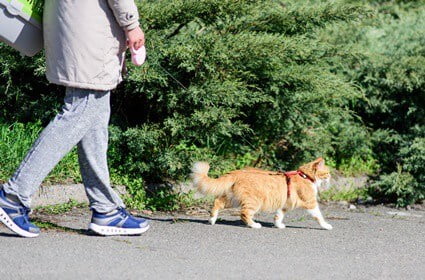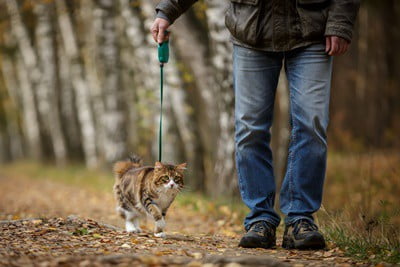Cats aren’t known for taking walks with their owners. However, they do need plenty of exercise to stay healthy, which indoor cats commonly lack. That’s why house cats may benefit from a daily outdoor walk.
Walking an indoor cat outside enables them to be active in a controlled way. It also has cognitive benefits, as it encourages cats to use their brains differently. However, walking your indoor cat outside exposes them to fleas, pesticides, and diseases. If your cat gets loose from its leash, it could get stolen or run over.
Training a cat to walk on a leash isn’t hard, but it takes time and patience. Most cats won’t enjoy the feeling of being restrained at first, but they’ll get used to it with positive reinforcement.
Can You Walk a Cat on a Leash?
By now, you’re probably wondering, “are you supposed to walk a cat?” It’s physically possible, but the reality is that even domesticated cats are free-roaming animals who hunt, explore, and fend for themselves. The idea of a cat being on a leash is an alien one for many owners and isn’t something that comes naturally to cats.
That being said, indoor cats are less adapted to the outdoors and don’t always retain the same wild tendencies as cats allowed free access to the outdoors. With training, cats can be taught to walk on a leash or cat harnesses and may enjoy the experience. As well as indoor pets, cats that benefit the most from being on a leash include those that:
- Are pedigrees who can’t be let outside on their own
- Don’t have regular access to the outdoors
- Need to lose weight
- Get bored and agitated from being indoors all day
- Are frequently bullied by neighborhood animals
- Are at high risk of theft
Leash-walking provides cats with exercise, enables them to stave off boredom, and helps them burn off excess energy. Be mindful that walking a cat is far different to walking a dog. Instead of leading the way, you’ll be following your cat as it darts off to explore and stops for a few seconds to have a sniff of its environment.
There are also these things to bear in mind when taking your indoor cat for a walk. According to the journal Animals, some studies suggest that outdoor access can negatively impact the welfare of companion cats because:
- The chances of exposure to fleas and other diseases are increased
- Some grasses and plants will be covered in pesticides and chemicals
- There’s a risk of your cat escaping its leash or harness – it may even get run over
- Dogs and other animals may chase after it and cause distress
- Your cat may become addicted to being outdoors and beg to go out there when inside
- Any of the above could trigger trauma and make your cat more scared of the outdoors
Similarly, if your cat hates being outside on a leash, don’t force it. You’ll only make it feel more nervous of the outdoors, and you may even damage your bond if your cat feels it can’t trust you. Some cats enjoy sitting by the window and watching what’s going on outside instead of being out there themselves. If this sounds like your cat, leave it be and play with it using toys and games instead.
Is It Normal To Walk a Cat?
It’s rare to see owners walking their cats on a leash. Owners are also divided on whether it’s a good thing to do or not. As mentioned, anything that isn’t natural for cats can be considered abnormal, but that doesn’t necessarily mean you shouldn’t do it.
As our environments become more urbanized and there are more dangers to worry about, such as traffic and theft, using a leash is a good way to enable indoor cats to experience the outside world without getting lost, stolen, or injured. However, it’s still highly unusual to see a cat being walked on a leash.
Also, if you do choose to walk your cat on a leash, be prepared to receive strange looks and unpleasant comments from strangers who don’t understand why you’re walking your cat. Similarly, thanks to today’s social media-dominated world, don’t be alarmed if you find yourself doing the rounds online. Until leash-walking becomes more normalized, you’ll need to develop a thick skin.
Is Walking a Cat on a Leash Cruel?
Many animal charities and organizations discourage owners from taking their cats outside for a walk. This is because doing so is likely to cause them distress. Cats enjoy having a sense of control over their lives.
Going for a walk on a leash or harness takes that away from them, making it difficult to run and hide from anything that scares them. Free-roaming cats climb trees or hide under bushes to get away from danger, which leashes and harnesses don’t allow them to do.
An indoor environment that provides plenty of opportunities for cats to be mentally and physically enriched is far safer and should provide them with everything they need to be happy and healthy.
However, leash-walking isn’t all bad. You could even suggest it’s crueler to stop cats from going outside, especially if they’re going mad trying to gain access to the outdoors. Walking a cat on a leash gives it the opportunity to:
- Roll around in dirt, sand, and grass
- Scratch trees
- Use its brain in different ways
- Work out how to use its body
- Experience new and unusual scents
- Build confidence
Depending on your cat’s personality and confidence levels, walking it on a leash could be a great way to teach it new skills and offer experiences it doesn’t otherwise have. Deciding whether to walk your cat or not is a personal one – one that you must carefully consider and carry out safely.
At What Age Can You Walk a Cat?
It’s not safe for cats to go outside until they have their first injections, which is usually when they’re around 13-14 weeks old. Before this time, they’re not protected against severe infectious diseases, such as:
- Feline infectious enteritis
- Feline leukemia virus
- Cat flu (feline herpes virus and feline calicivirus)
Once your cat’s had these jabs, you can start leash training. It’s better to start training indoor cats when they’re young to get them used to being on a leash or harness. Older, more established cats are less likely to accept being restrained and may refuse to go outdoors.

How Long Should I Walk My Cat?
While there isn’t a specific time limit you should follow, you shouldn’t engage in long walks with your cat – at least not until it’s used to being on a leash or harness. Your cat will guide you on time whenever you’re on your walk. Some cats enjoy being out for hours, while others only like a short walk.
In most cases, as soon as your cat’s finished with being outside, it’ll head home. According to Science Monthly, Professor Frances Herrick discovered that cats have a homing instinct by observing a mother cat making her way back to her kittens from four miles away. This means cats can find their way home by following familiar scents.
Keep walks short in cold or hot temperatures, and don’t take your cat outside when it’s raining. Cats don’t enjoy getting wet, so you should try to stick to dry weather walks as often as you can.
How To Train a Cat To Walk On a Leash
Despite misconceptions, cats are trainable. This means with patience and consistency, you can train them to walk on a leash. The process will be long and slow, and that’s because your cat’s likely to reject being restrained at first. However, keep going, as you’ll get there in the end if you try. Learn how to walk a cat without a leash with these steps:
Step 1: Get Your Cat Used to a Harness
The first step is to get your cat used to the harness before you move onto the leash. A harness is more comfortable, so it’ll make your cat feel more at ease. Attach it to your cat without attaching the leash and give your pet a couple of its favorite treats.
Slowly take the harness off and keep repeating this process while gradually increasing the amount of time you leave it on for. Only give your cat treats when it’s wearing the harness to encourage it to form positive associations.
Step 2: Get Your Cat Used to a Leash Indoors
Once your cat seems comfortable wearing the harness for a decent amount of time, attach the leash. Let go of the leash and leave it loose as your cat walks around the house with it on. Your pet might get freaked out during this stage, so be sure to move slowly with this step.
After a short while, remove the leash and keep repeating the process over a period of a few days. Eventually, your cat will become more relaxed walking around with the harness and leash.
Step 3: Add Tension to the Leash
The next step is to supervise your cat while dragging the leash behind it when walking around the home. Don’t remove the leash – wait until your cat feels comfortable with a little bit of tension. Always watch your cat during this process in case it gets caught on something or becomes agitated.
Step 4: Walk Your Cat Indoors
Repeat step two and let your cat walk around the house for a short amount of time wearing the harness. Once your cat’s moved around a little, use the leash to encourage your pet to move in another direction.
Be careful not to pull or use excessive force. If your cat doesn’t play ball, use treats or affection (depending on its preference) to encourage it to move in the desired direction. Eventually, your cat will move on command without the need for positive reinforcement.
Step 5: Try Walking Outside
The final step is to walk your cat to an open door and encourage it to go outside. Make sure you do this on a warm, dry day, or your cat will want to stay indoors. You can lure your cat by tossing a treat a few inches away from the door. However, don’t force your cat to go outside. If it isn’t willing at this stage, it needs a bit more time.
When your cat’s ready to go on a walk, take some treats so that you can help it change direction whenever you need to. Start by walking close to home and then gradually increase the distance each time you go out.

Cat Breeds You Can Walk On a Leash
Some breeds are happier to walk on a leash than others. If you have one of these indoor cats, try taking it out for a walk to burn off some energy and remain physically and mentally healthy.
Ragdoll
The Ragdoll is one of the best cat breeds for leash-walking because they love to be around their owners and naturally follow them around the house. This means they’re far more willing to walk on a leash with their favorite people than other cats are. However, their easy-going nature makes them an easy target for other animals, so be sure to keep a watchful eye on your cat whenever you’re on your walk.
Abyssinian
Abyssinians are one of the easiest cats to train. They’re adventurous and love meeting new people, so they’re not put off by busy outdoor environments. Many Abyssinians follow their owners outside as they head into the garden, so they’re adaptable and willing to walk on a leash. They’re athletic and have lots of energy, so make sure you always hold onto the leash tightly in case your cat suddenly bolts.
Bengal
Despite their athletic build and predatory nature, Bengal cats are a wilful and dutiful cat breed that is highly loyal to their owners. They’re a high theft risk and fetch thousands on the black market, so they should be kept as indoor cats. However, because they need so much exercise, they need more walks than most other cats. Thankfully, they love to be busy, so they’re usually more than happy to be leash trained as it keeps them entertained.
Savannah
Savannah cats are often likened to dogs because of their dog-like traits. Because of their high energy levels, they need plenty of exercise to remain mentally and physically healthy. They’re intelligent, quick-learning cats, so they’ll pick up leash-walking in no time. They’re also loyal, so they’ll remain close to their owners on their walks. However, some Savannah kittens suffer from fear and anxiety, so it’s best to start leash training young to prevent this.
Burmese
Burmese cats form strong bonds with their owners and display dog-like tendencies that make them such endearing pets. Some can even be trained to play fetch like a canine. They’re energetic, curious, and easily bored, so they benefit from frequent outdoor walks. Alongside walks, Burmese cats also need access to challenging toys and puzzles to keep their minds sharp and active.
Maine Coon
Maine Coons are larger cats than most other breeds. They’re famous for being gentle giants and love the attention they receive on their walks. Because they’re so curious, they’ll walk alongside you on their leash. Maine coons don’t tend to enjoy being outside for very long, but they’ll enjoy the time they spend away from home. However, Maine Coons have long, fluffy coats, so you’ll need to clean and brush their fur after every walk.
Whether you choose to take your indoor cat for a walk or not depends on the safety of where you live and how willing your cat is to go outside. If your cat’s desperate to go outside, it may benefit from a walk. If it prefers to remain inside, leave it be and provide plenty of mentally enriching games and toys.

